Based outside the town of Strabane, Co Tyrone, Mark Dooher farms part-time alongside his father Charlie. The two main farming enterprises are sucklers and sheep.
The duo run 45 predominately Charolais suckler cows, with calving split between spring and autumn. On the sheep side of things, the Doohers lamb 145 commercial ewes which are later finished on the farm. In addition to the commercial flock, Mark and his wife have ventured into the Dutch Spotted and Blue Texel pedigree breeds in recent years.
In December 2020, the Doohers purchased a new 2.9m3 VDW mounted mini diet feeder from the newly appointed Northern Irish dealer at the time, McMullan Agri, based in Ballymoney, Co Antrim.
Having considered the option of a conventional diet feeder several times, the major issue ruling it out each time was shed layout and lack of yard space, according to Mark and his father.
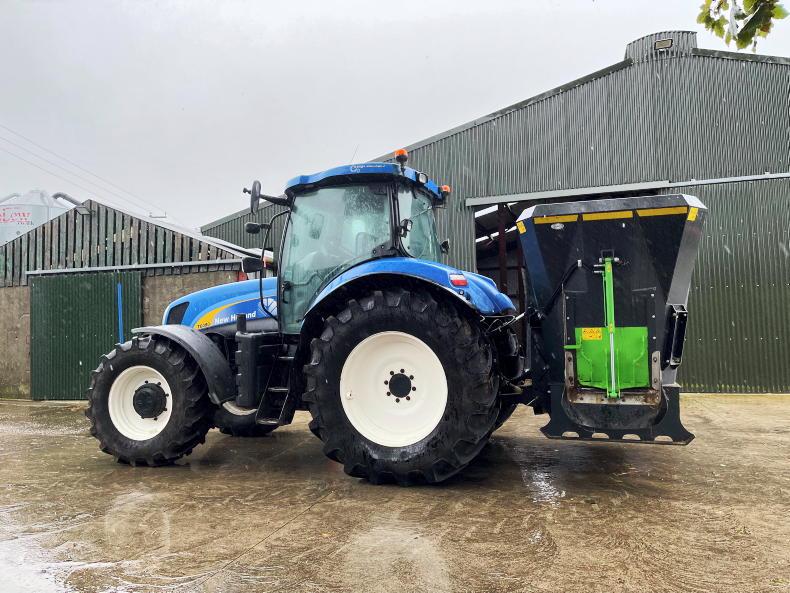
The Doohers opted for the largest model in the range with 2.9m3 loading capacity.
Mark said: “Before we bought the mounted diet feeder, all feeding was done using our Case SR130 skid steer and 4ft 3in shear grab. As handy as the skid steer was for the job, there was always silage to be pushed in manually.”
Shortly after the appointment of McMullan Agri as dealer for VDW, a brand not known to most of the country’s farmers at the time, Mark happened to spot the mounted diet feeder on social media.
“Straight away having seen the feeder I knew it would suit our farm. It was the best solution I had seen and have seen to date for a confined yard or smaller farm,” Mark said.
Without much hesitation, Mark made some enquiries and bought a 2.9m3 model during the winter of 2020. “The decision was easy really, there was no other comparable machine on the market.”
Build and design
Belgian manufacturer VDW designs and builds a suite of unique and quirky feeding solutions in addition to diet feeders including straw blowers, fodder buckets and other attachments. Its vertical mixer range is available in two forms – tipping and non-tipping.
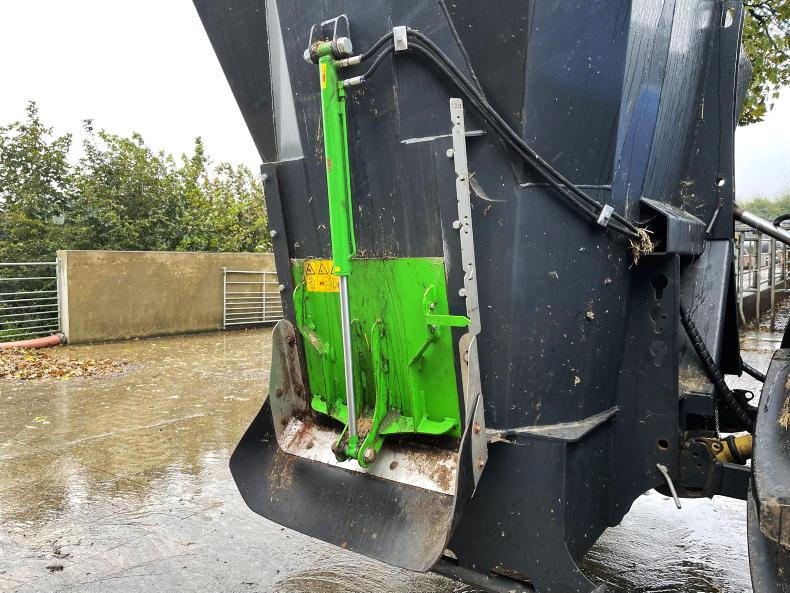
A guillotine door is fitted on both sides as standard.
Tipping is whereby the tub itself tips down and self-loads similar to a loader bucket. The Doohers went with the fixed non-tipping model.
Within the firm’s range of fixed vertical feeders, there are four models ranging from 1.9m3 to 2.9m3 in capacity. Each auger is equipped with four serrated knives with room on each for an additional two knives on each if required. Both Mark and Charlie praised its quick mixing and chop qualities. Mark puts both these traits down to the fact the augers are working in such a confined area, leaving little dead space for forage to escape coming in contact with either auger.

Each auger is equipped with three serrated edge blades with option of fitting four if required.
However, Mark did note that on rare occasion’s material can lodge in the top corners of the feeder. This is something that could have been easily avoided if the tub had more rounded corners as opposed to angular corners, he pointed out.
Two discharge doors are fitted as standard, one on both the left and right side, each requiring a double-acting spool. Lights are also fitted as standard while the option of augers manufactured using harder-wearing Cobranox steel is available. Magnets are also available to remove any iron particles or debris from the feed.
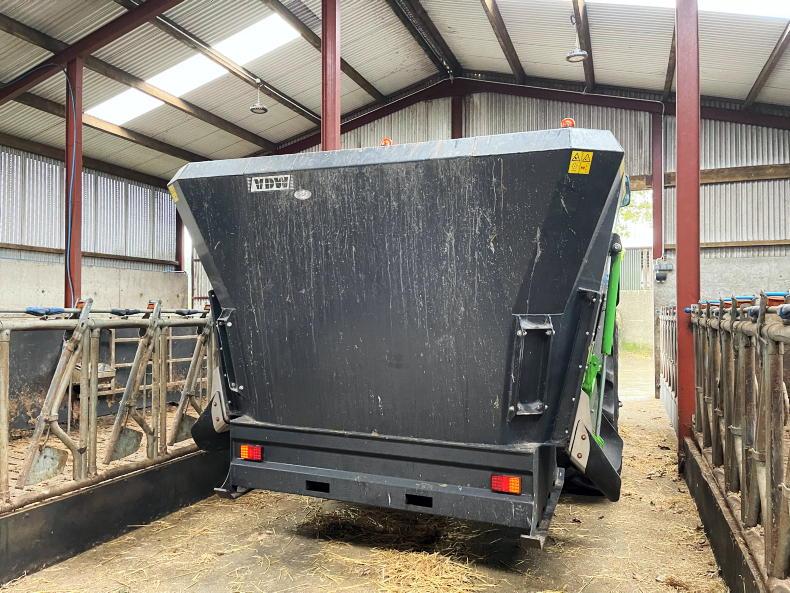
Given the width of the centre passages on the farm means the feeder can feed out to both the left and right side at once.
Speaking around the topic of build quality, Mark said that even his brother who is a welder by trade was well impressed with the build quality of the feeder.
The machine weighs in empty at 1,300kg and Mark said: “It’s a heavy built machine but is very easily driven. They say as little as 80hp is enough to power it which I’d believe. But weighing well over 2,000kg full, weight is more important. We run it on a New Holland TM130 which is just enough from a weight perspective. It needs the front weights for ballast.”
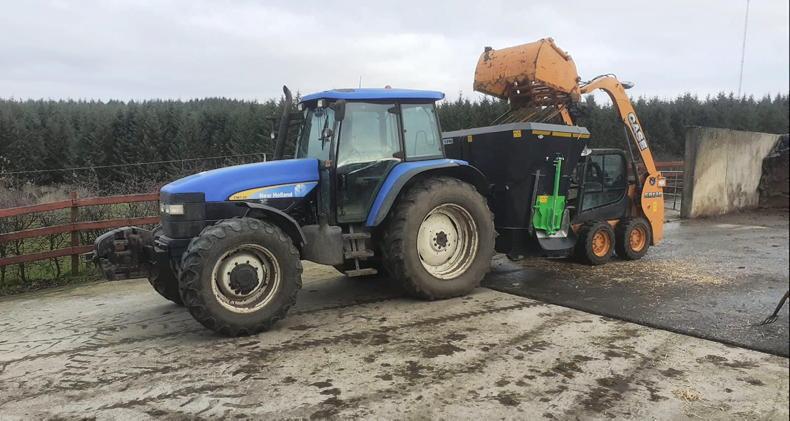
The Doohers load the feeder using the farms Case SR130 skid steer.
Feeding
Mark said: “During the winter housed period, the feeder is in use daily. We use it to feed all the cows and sheep. We load it using the skid steer, a typical mix consists of two grabs straw and five grabs of precision-chop pit silage. We leave it mixing for roughly five minutes. At that point the straw is well chopped and mixed through. We don’t feed many bales here on the farm but we have tested them in the feeder which it is well capable of handling. However, for both ease of loading and mixing, we tend to split them with the shear grab.
“The benefit of the VDW-mounted feeder over a conventional trailed machine is that we can reverse right up to the gable end wall of the slatted shed and start feeding out right from the wall, whereas with most feeders this is impossible unless the feeder has a rear discharge conveyor.

Mark and Charlie Dooher.
“Our passages are 12ft wide which coincidentally means the feeder feeds out perfectly to both sides in one pass. If there are young stock on one side of the shed and calved cows on the other, both doors can be opened to different extents using their own individual spools. The scale on each door is easily visible from the cab too.”
“Since we started diet feeding in 2020, we’ve seen a number of benefits, the first being a major reduction in waste,” Mark said. “Practically everything is eaten, which we put down to the fact stock always get fresh feed in a consistent mix that is well fed out. The second notable benefit is the time saved feeding as the skid steer is no longer trekking back and forth from the pit. In addition to that there is no time spent manually forking feed.”
Both father and son believe stock have done a slightly better thrive since making the move.
“What’s more, we have the option of incorporating straights or concentrates consistently into the diet if we wish.
“It’s not the solution for everyone but a good option for sheep farms or a situation similar to our own where a conventional feeder isn’t best suited. On average, we feed 45 cows and 145 ewes with it daily. It’s probably nearing its limit at that but, it comes down to how long you want to spend feeding daily.
“Build quality cannot really be faulted, there are minimal signs of wear yet which is positive. In terms of maintenance, we go through it every year before winter kicks off as we do with all machinery and keep it greased regularly throughout the season.”
Aside from replacing blades at some point in the future, we expect the running costs to remain low,” the duo concluded.
Capacity: 2.9m3.
Unladen weight: 1,300kg.
Power requirement: 80hp.
Width: 2.6m.
No of blades: 8 (four per auger).
No of discharge doors: Two.
Starting list price: €13,770 (£12,000) plus VAT.
Based outside the town of Strabane, Co Tyrone, Mark Dooher farms part-time alongside his father Charlie. The two main farming enterprises are sucklers and sheep.
The duo run 45 predominately Charolais suckler cows, with calving split between spring and autumn. On the sheep side of things, the Doohers lamb 145 commercial ewes which are later finished on the farm. In addition to the commercial flock, Mark and his wife have ventured into the Dutch Spotted and Blue Texel pedigree breeds in recent years.
In December 2020, the Doohers purchased a new 2.9m3 VDW mounted mini diet feeder from the newly appointed Northern Irish dealer at the time, McMullan Agri, based in Ballymoney, Co Antrim.
Having considered the option of a conventional diet feeder several times, the major issue ruling it out each time was shed layout and lack of yard space, according to Mark and his father.

The Doohers opted for the largest model in the range with 2.9m3 loading capacity.
Mark said: “Before we bought the mounted diet feeder, all feeding was done using our Case SR130 skid steer and 4ft 3in shear grab. As handy as the skid steer was for the job, there was always silage to be pushed in manually.”
Shortly after the appointment of McMullan Agri as dealer for VDW, a brand not known to most of the country’s farmers at the time, Mark happened to spot the mounted diet feeder on social media.
“Straight away having seen the feeder I knew it would suit our farm. It was the best solution I had seen and have seen to date for a confined yard or smaller farm,” Mark said.
Without much hesitation, Mark made some enquiries and bought a 2.9m3 model during the winter of 2020. “The decision was easy really, there was no other comparable machine on the market.”
Build and design
Belgian manufacturer VDW designs and builds a suite of unique and quirky feeding solutions in addition to diet feeders including straw blowers, fodder buckets and other attachments. Its vertical mixer range is available in two forms – tipping and non-tipping.

A guillotine door is fitted on both sides as standard.
Tipping is whereby the tub itself tips down and self-loads similar to a loader bucket. The Doohers went with the fixed non-tipping model.
Within the firm’s range of fixed vertical feeders, there are four models ranging from 1.9m3 to 2.9m3 in capacity. Each auger is equipped with four serrated knives with room on each for an additional two knives on each if required. Both Mark and Charlie praised its quick mixing and chop qualities. Mark puts both these traits down to the fact the augers are working in such a confined area, leaving little dead space for forage to escape coming in contact with either auger.

Each auger is equipped with three serrated edge blades with option of fitting four if required.
However, Mark did note that on rare occasion’s material can lodge in the top corners of the feeder. This is something that could have been easily avoided if the tub had more rounded corners as opposed to angular corners, he pointed out.
Two discharge doors are fitted as standard, one on both the left and right side, each requiring a double-acting spool. Lights are also fitted as standard while the option of augers manufactured using harder-wearing Cobranox steel is available. Magnets are also available to remove any iron particles or debris from the feed.

Given the width of the centre passages on the farm means the feeder can feed out to both the left and right side at once.
Speaking around the topic of build quality, Mark said that even his brother who is a welder by trade was well impressed with the build quality of the feeder.
The machine weighs in empty at 1,300kg and Mark said: “It’s a heavy built machine but is very easily driven. They say as little as 80hp is enough to power it which I’d believe. But weighing well over 2,000kg full, weight is more important. We run it on a New Holland TM130 which is just enough from a weight perspective. It needs the front weights for ballast.”

The Doohers load the feeder using the farms Case SR130 skid steer.
Feeding
Mark said: “During the winter housed period, the feeder is in use daily. We use it to feed all the cows and sheep. We load it using the skid steer, a typical mix consists of two grabs straw and five grabs of precision-chop pit silage. We leave it mixing for roughly five minutes. At that point the straw is well chopped and mixed through. We don’t feed many bales here on the farm but we have tested them in the feeder which it is well capable of handling. However, for both ease of loading and mixing, we tend to split them with the shear grab.
“The benefit of the VDW-mounted feeder over a conventional trailed machine is that we can reverse right up to the gable end wall of the slatted shed and start feeding out right from the wall, whereas with most feeders this is impossible unless the feeder has a rear discharge conveyor.

Mark and Charlie Dooher.
“Our passages are 12ft wide which coincidentally means the feeder feeds out perfectly to both sides in one pass. If there are young stock on one side of the shed and calved cows on the other, both doors can be opened to different extents using their own individual spools. The scale on each door is easily visible from the cab too.”
“Since we started diet feeding in 2020, we’ve seen a number of benefits, the first being a major reduction in waste,” Mark said. “Practically everything is eaten, which we put down to the fact stock always get fresh feed in a consistent mix that is well fed out. The second notable benefit is the time saved feeding as the skid steer is no longer trekking back and forth from the pit. In addition to that there is no time spent manually forking feed.”
Both father and son believe stock have done a slightly better thrive since making the move.
“What’s more, we have the option of incorporating straights or concentrates consistently into the diet if we wish.
“It’s not the solution for everyone but a good option for sheep farms or a situation similar to our own where a conventional feeder isn’t best suited. On average, we feed 45 cows and 145 ewes with it daily. It’s probably nearing its limit at that but, it comes down to how long you want to spend feeding daily.
“Build quality cannot really be faulted, there are minimal signs of wear yet which is positive. In terms of maintenance, we go through it every year before winter kicks off as we do with all machinery and keep it greased regularly throughout the season.”
Aside from replacing blades at some point in the future, we expect the running costs to remain low,” the duo concluded.
Capacity: 2.9m3.
Unladen weight: 1,300kg.
Power requirement: 80hp.
Width: 2.6m.
No of blades: 8 (four per auger).
No of discharge doors: Two.
Starting list price: €13,770 (£12,000) plus VAT.












 This is a subscriber-only article
This is a subscriber-only article






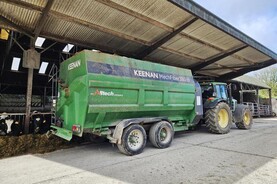



SHARING OPTIONS: